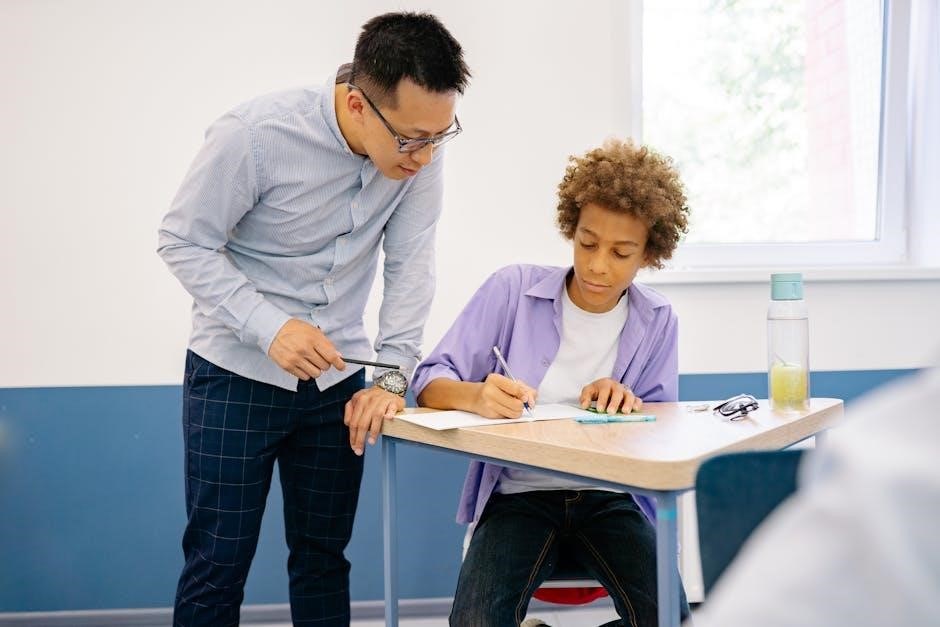The first day of school is a significant milestone, blending excitement with nervousness, marking a fresh start, and offering opportunities for growth and connection;
Historical Overview of the First Day of School
The first day of school has evolved significantly over time, reflecting societal changes and educational reforms. In ancient civilizations, such as Greece and Rome, education was reserved for the elite, with the first day marking the beginning of philosophical and rhetorical training. During the Middle Ages, formal education was primarily accessible to the clergy, with monasteries serving as centers of learning. The Industrial Revolution brought compulsory education, making the first day of school a universal experience for children. In the 20th century, advancements in pedagogy and inclusivity transformed the first day into a welcoming event, emphasizing student-centered approaches. Today, the first day of school symbolizes opportunity, growth, and the foundation of lifelong learning, with practices adapting to modern educational priorities.
Emotional Significance of the First Day
The first day of school holds profound emotional significance, blending excitement, nervousness, and hope. For students, it marks a fresh start, filled with opportunities to learn and connect. Many experience a mix of emotions, from eagerness to meet new friends to apprehensions about adapting to a new environment. Parents often feel a sense of pride and nostalgia, witnessing their child take a significant step toward independence. The first day sets the tone for the academic year, shaping initial impressions and attitudes toward learning. It’s a moment of transition, where curiosity and anticipation lay the groundwork for personal growth and development. Capturing these emotions, whether through reflection or conversation, helps students and families process this meaningful experience.
Importance of Preparation for the First Day
Preparation for the first day of school plays a crucial role in ensuring a smooth transition for students. Gathering necessary supplies, such as notebooks and pencils, helps students feel organized and ready to learn. Establishing a routine, including a consistent sleep schedule and a morning checklist, reduces chaos and builds confidence. Discussing expectations and goals with children can alleviate anxiety and foster a positive mindset. Parents should also communicate with teachers to address any concerns, ensuring alignment between home and classroom. Emotional preparation, such as talking about feelings and encouraging open communication, helps students navigate the transition. A well-prepared start sets the foundation for a successful and enjoyable academic year, promoting both academic and emotional readiness.

Diary Entries and Reflections
Diary entries and reflections provide a meaningful way for students to capture their emotions and thoughts about the first day of school, fostering self-expression and personal growth.
Example Diary Entry for the First Day of School
Dear Diary,
Today was my first day of school, and it was a mix of excitement and nerves. As I walked into my classroom, I felt a little shy but curious about meeting new classmates and teachers. My heart raced when the bell rang, but everyone seemed friendly. I made a few friends during recess, and we talked about our summer breaks. The lessons were interesting, and I enjoyed learning new things. By the end of the day, I felt more confident and eager to come back tomorrow. I wonder what the rest of the year will bring!
Reflecting on the day, I realized how important it is to step out of my comfort zone and embrace new experiences.
Reflection Questions for Students
Reflecting on the first day of school can help students process their experiences and emotions. Here are some thoughtful questions to guide their reflection:
- What were your initial feelings when you walked into the school or classroom?
- Who were the people you met today, and how did they make you feel welcome?
- What did you learn about yourself or your classmates today?
- What are you most excited about for the upcoming school year?
- What challenges do you think you might face, and how can you overcome them?
- What surprised you the most about today?
- What are your goals for this school year, and how will you work toward achieving them?
These questions encourage students to think deeply about their first-day experiences and set a positive tone for the year ahead.
Creative Writing Prompts for the First Day
Creative writing prompts can help students express their thoughts and feelings about the first day of school. Here are some engaging ideas:
- Write a story about your first-day adventure, including the people you met and the challenges you faced.
- Imagine you are a new object in the classroom—describe your first day from that perspective.
- Write a poem about the emotions you felt when you walked into school.
- Describe your ideal first day of school and how it compares to your actual experience.
- Write a letter to your future self about what you hope to achieve this year.
- Imagine you could switch lives with a classmate for a day—how would your first day differ?
These prompts inspire creativity and self-expression, helping students reflect on their first-day experiences in a fun and imaginative way.

Parental Guidance and Support
Parents play a vital role in easing first-day jitters by offering reassurance, establishing routines, and fostering open communication to ensure their child feels prepared and supported.
Tips for Parents to Prepare Their Child
Parents can significantly ease their child’s transition by establishing consistent routines, discussing expectations, and fostering open communication. Encourage your child to express their feelings and concerns, offering reassurance and support. Practical steps include organizing school supplies, ensuring a good night’s sleep, and planning a healthy breakfast. Familiarize your child with the school environment, if possible, to reduce anxiety. Encourage positive thinking and remind them of past successful experiences. Stay calm and positive yourself, as your attitude can greatly influence your child’s emotions. By creating a supportive and structured approach, you can help your child feel confident and ready for their first day of school.
How to Help Children Overcome First-Day Nervousness
Helping children overcome first-day nervousness begins with open communication and empathy. Encourage your child to share their feelings and concerns, creating a safe space for them to express emotions. Normalize their nervousness by explaining that it’s natural and many children feel the same way. Offer practical advice, such as role-playing scenarios or discussing what to expect. Focus on positive reinforcement, highlighting their strengths and past successes. Remind them that it’s okay to feel anxious and that they can always reach out for support. Establishing a consistent routine and ensuring they are well-rested can also help reduce anxiety. By fostering a supportive environment, you can empower your child to approach their first day with confidence and curiosity.
Importance of Communication with Teachers
Effective communication with teachers is crucial for a smooth transition on the first day of school. Parents should introduce themselves and share relevant information about their child, such as strengths, challenges, and any special needs. This collaboration helps teachers understand individual requirements, fostering a supportive learning environment. Regular updates and open dialogue ensure alignment between home and school, promoting consistency in expectations and routines. Encouraging children to communicate with teachers about their feelings or concerns also builds trust and confidence. By maintaining clear and respectful communication, parents and teachers can work together to address any challenges and celebrate successes, ultimately supporting the child’s academic and emotional growth throughout the year.

Classroom Activities and Icebreakers
Engaging classroom activities and icebreakers on the first day help students connect, build confidence, and establish a positive learning environment through fun, interactive, and collaborative experiences.
Fun Icebreaker Games for Students

Engaging icebreaker games are essential for creating a welcoming atmosphere on the first day of school. One popular activity is “Two Truths and a Lie,” where students share two true statements and one false statement about themselves, encouraging others to guess which one is the lie. Another fun game is “Human Bingo,” where students circulate to find peers who fit specific traits or hobbies listed on a bingo card. “The Name Game” is also effective, involving introductions paired with unique facts or gestures to help classmates remember names. These activities foster connection, reduce nervousness, and set a positive tone for the year. They also encourage creativity and teamwork, making the first-day experience memorable and enjoyable for everyone involved.
Engaging First-Day Classroom Activities

Engaging first-day classroom activities help students transition smoothly into the academic environment. A collaborative poster project, where students contribute to a shared visual representation of their goals or interests, fosters teamwork and creativity. Interactive lessons, such as problem-solving puzzles or group brain teasers, encourage critical thinking and collaboration. Teachers can also incorporate reflection time, allowing students to write or draw about their expectations and aspirations for the year. Additionally, introducing classroom routines through hands-on activities, like organizing supplies or creating a class chart of responsibilities, helps establish structure. These activities not only make the first day enjoyable but also set the foundation for a positive and productive learning environment. They help students feel comfortable, build connections, and develop a sense of ownership in their educational journey.
Team-Building Exercises for Students
Team-building exercises on the first day of school help students bond and establish a collaborative classroom atmosphere. Activities like “Two Truths and a Lie” encourage students to share personal anecdotes, fostering connections. Group challenges, such as solving a puzzle or completing a scavenger hunt, promote teamwork and communication. Teachers can also organize collaborative games that require problem-solving, like building a bridge with limited materials, to enhance creativity and trust. These exercises not only break the ice but also help students feel comfortable working together. By fostering a sense of unity, these activities set the tone for a supportive and inclusive learning environment throughout the year. They empower students to collaborate effectively and build lasting friendships.

Teacher’s Perspective and Strategies
Teachers prepare meticulously for the first day, organizing lesson plans, creating a welcoming environment, and being ready to support students’ initial needs and experiences.
Creating a Welcoming Classroom Environment
Establishing a welcoming classroom environment is crucial for the first day of school. Teachers can achieve this by arranging the room to promote interaction and comfort. Seating arrangements should encourage collaboration, while decorations like inspiring quotes and colorful displays can create a positive atmosphere. Icebreaker activities and team-building exercises help students feel connected. A calm and approachable demeanor from the teacher sets a reassuring tone. Clear communication of expectations and routines minimizes confusion. Personalized touches, such as student name tags or introductory games, foster inclusivity. A well-organized and inviting space ensures students feel comfortable and ready to engage, laying the foundation for a successful academic year.
Effective Strategies for the First Day
Effective strategies for the first day of school focus on setting a positive tone and building connections. Start with a strong opening to establish expectations and routines. Use icebreakers that encourage interaction and help students feel comfortable. Clearly communicate classroom rules and expectations while fostering a sense of community. Incorporate engaging activities that allow students to share their thoughts and interests. A well-structured lesson plan ensures productivity while allowing time for questions. Ending the day with a positive note, such as reflecting on highlights, reinforces a sense of accomplishment; These strategies help create a supportive environment, ensuring students leave feeling confident and excited for the year ahead.
Assessing Student Needs on the First Day
Assessing student needs on the first day is crucial for understanding their academic and emotional readiness. Teachers can observe students’ participation in activities and conversations to gauge their confidence and engagement. Simple icebreakers and introductory exercises provide insights into students’ personalities, learning styles, and communication skills. Informal chats during activities help identify individual strengths and challenges. Additionally, brief writing prompts or reflection questions can reveal students’ thoughts and feelings about the school experience. These observations guide teachers in tailoring instruction and support, ensuring each student feels understood and valued. By creating a safe and inclusive environment, educators lay the foundation for a successful and supportive academic year.
The first day of school is a blend of emotions and opportunities. Preparation, support, and open communication are key to a smooth transition. Explore additional resources for further guidance.
The first day of school is a milestone filled with emotions, marking the start of new experiences, friendships, and learning. Preparation is crucial, from organizing supplies to addressing nervousness. Parents play a vital role in supporting their child, while teachers create a welcoming environment. Classroom activities and icebreakers help students connect and feel comfortable. Open communication between families and educators ensures a smooth transition. The first day sets the tone for the academic year, emphasizing the importance of a positive and organized start. Balancing excitement with nervousness, the first day is a foundation for growth, connection, and success.
Recommended Resources for Further Reading
For further insight into navigating the first day of school, consider exploring resources like “First-Day-of-School Writing Prompts” and “Reflection Questions for Students.” These tools help students articulate their feelings and experiences. Additionally, guides such as “Tips for Parents to Prepare Their Child” and “How to Help Children Overcome First-Day Nervousness” offer practical advice for families. Educational websites and blogs provide engaging classroom activities, icebreakers, and team-building exercises. Books like “The First Day of School” and online articles on creating a welcoming classroom environment are valuable for teachers. Checklists, printable worksheets, and articles on communication with teachers can also support a smooth transition. These resources ensure a positive and organized start to the academic year.